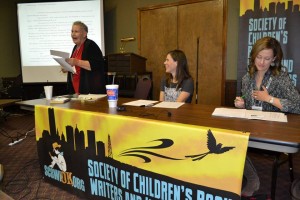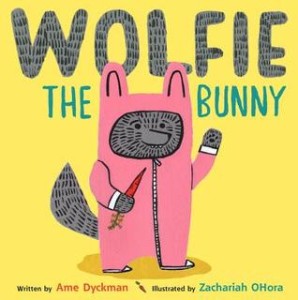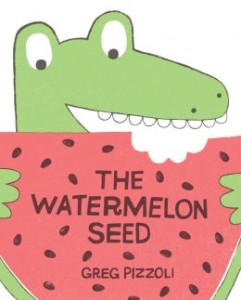While at the 2015 SCBWI-OK Fall Retreat, I participated on a first page/first fifty panel. The other panelists, Anna Myers and Sonia Gensler, offered feedback on the first pages of novel manuscripts. My job was to offer feedback on the first fifty words of picture book manuscripts.
No small task.
When it comes to picture books, each word needs to pack a punch. If you can’t grab readers in those first fifty, then, chances are, it would be quite challenging to grab them at word fifty-one.
In those first fifty words, a picture book should convey a lot of information. Readers are generally introduced to the main character, the conflict, and the book’s tone.
At the retreat, I was also asked to share two examples of strong picture book beginnings and explain why they worked. I chose Wolfie the Bunny, written by Ame Dyckman and illustrated by Zachariah OHora, and The Watermelon Seed, written and illustrated by Greg Pizzoli.
Since the retreat attendees seemed to enjoy my analysis, I decided to share those examples and my thoughts here on the blog.
The first fifty words of Wolfie the Bunny:
The bunny family came home to find a bundle outside their door.
They peeked.
They gasped.
It was a baby wolf!
“He’s adorable!” said Mama.
“He’s ours!” said Papa.
“HE’S GOING TO EAT US ALL UP!” said Dot.
But Mama and Papa were too smitten to listen.
My thoughts on the first fifty:
- Right away, readers are introduced to the main character, the conflict, and the book’s tone
- In the first line, there is a pleasant-to-the-ear repetition of the “bun” sound in “bunny” and “bundle”
- In the first line, there is also consonance with the words “family,” “came,” and “home”
- Readers immediately want to know what’s in the bundle which creates a nice moment of suspense
- The words “peeked” and “gasped” are strong action verbs
- The line “It was a baby wolf!” is completely unexpected and makes readers want to know what will happen next
- The dialogue is a great example of the Rule of 3’s—both Mama and Papa’s line follow a basic pattern, but Dot’s comment stands out because it not only breaks the pattern, but it is presented in all caps
- There’s a nice contrast between the main character’s small name “Dot” and the big voice she uses when she makes her announcement
- Readers know a lot about these characters even though each bunny has only one line of dialogue
- The fact that Mama and Papa seem taken by this baby wolf is unexpected which adds to the humor
- In the last line, there is assonance with the words “smitten” and “listen”
The first fifty words of The Watermelon Seed:
I love watermelon!
CHOMP! CHOMP! CHOMP!
It’s the best.
Ever since I was a teeny, tiny baby crocodile, it’s been my favorite.
CHOMP! SLURP! CHOMP!
I like it for breakfast.
I liked it for lunch.
I like a big salty slab for dinner…
And I LOVE it for dessert!
I love watermelon!
Gulp.
I just swallowed a seed.
My thoughts on the first fifty:
- Right away, readers are introduced to the main character, the conflict, and the book’s tone
- The character has a clear personality
- The text has energy
- This is fun to read aloud
- There’s nice use of onomatopoeia—“CHOMP! CHOMP! CHOMP!” and “CHOMP! SLURP! CHOMP!” and “Gulp.”
- There are a couple of moments of alliteration—“teeny, tiny” and “salty slab”
- When the crocodile states what he likes, he uses the Rule of 3’s
- The period at the end of the word “Gulp.” gets our attention, and we realize that the crocodile’s demeanor has suddenly changed
- The line “I just swallowed a seed.” is brilliant because everyone can relate to the situation, the reader knows that this is the character’s moment of trouble, and it’s funny
If you are a picture book writer, I hope this post gives you something to think about as you create your irresistible beginnings. Also, if you have a favorite picture book beginning that you’d like to recommend, please do so in the comments.
Happy writing!




First Fifty–new to me. Thanks so much for sharing your review of two great books. Very helpful indeed!
Great revision nugget! Thank you for breaking it down as you did, too!
Thanks, Linda! I made up the “first fifty.” I truly think that’s all an editor needs to see before deciding if he/she wants to read on or not.
You’re welcome, Kelly!
I love this post! Thanks for sharing your analysis of the first 50 words…what a great strategy to make sure your pb has legs to stand on!
You’re welcome!
LOVE this, Tammi! I did something similar at the Minnesota conference: You’ve Got 30 Seconds (to Wow an Editor). Here’s one of my favorite openings, from The Dullards, by Sara Pennypacker:
One day, Mr. and Mrs. Dullard received quite a nasty surprise.
The Dullards collected the books and handed their children some nice blank paper to read instead. Then they left the room to discuss the problem in private.
—–
Only 38 words, and a reader’s going, “Wait…wha?!”
Ooh! Great example.
So helpful to see your breakdown. Thanks for sharing.
You’re welcome!
What an excellent post. I’m off or review my openings for my WIPs with a fresh eye. Thanks so much!
Yay! I’m glad this was helpful to you.
Wow–what an excellent analysis. I love that you emphasize the SOUND of words as much as the meaning. Thanks, Tammi!
Yes! The SOUND is so important–especially since most of the time, pbs are being read out loud.
Love this post and the examples you use. I entered a contest using the first 50 words and it can be very telling if you have grabbed your reader or not.
Yep. Those first fifty are often all it takes for an editor/agent to want to read on or not.
Hugely helpful post! Thank you, Tammi! Off to check my first 50…. =)
You’re welcome!
Love this post and how you break down the first 50 in such detail. I’m going to start checking my first 50!
Hooray!
Wonderful post, Jill – with thanks for powerful and concise revision tips!
This one’s from Tammi, Carol. But I agree! Wonderful post. 🙂
Thanks, Carol and Jill. 🙂
If a picture book doesn’t grab me on the first page or two, I’ll usually put it down and move on. One that grabbed me recently was Troll and the Oliver by Adam Stower. Such a cute book!
I’ll have to look for that one!
Love, love, love it! Thank you, thank you. 🙂
Yay!!!!
Thanks Tammi! This is such a helpful post!
You’re welcome, Jennifer. 🙂
Love your breakdown of the first 50, line by line, word by word. Excellent!
Thanks! 🙂
Wonderful examples and lesson. Thank you!
You’re welcome!
One of my favorite, less than 50 word openings, comes from Iggy Peck Architect, by Andrea Beaty: Young Iggy Peck is an architect and has been since he was two, when he built a great tower–in only an hour–with nothing by diapers and glue.
In 29 words I know I’m in for a good laugh as well as in the hands of a good storyteller.
Thanks for sharing this wonderful example. 🙂
Very helpful! I’m going back over my “first 50” in every story I’ve written and haven’t submitted (which is ALL of them!!).
Yay! Good luck. 🙂
Getting all this in the first 50, great advice! One of my all time favorite PB beginnings is from Owl Babies. I love the rhythm, the pacing, the tone.
Oh, I looooove that book. 🙂
Love this! Started reading, then had to stop and grab my notebook for notes!!!
Good! 🙂
Tammy, I love this post! Thank you. The examples you show really hammer the point home. I’m going to run (not walk) to my manuscripts and check out my first 50.
Here are the first 49 words of my latest favorite published picture book, “Bernice Gets Carried Away,” by Hannah E. Harrison:
It was a horrible, dreary day, and it suited Bernice’s mood just fine.
Everyone else had gotten a frosting rose on their piece of cake…
…but not Bernice.
All she’d gotten was a plain white square from the middle.
Everyone else had gotten ice-cold strawberry-melon sodas…
…but not Bernice.
Can I do one more…please? This one is lots of fun. “Glamourpuss,” by Sarah Weeks:
Once upon a pillow sat a glamourous cat named Glamourpuss.
Glamourpuss lived with Mr. and Mrs. Highhorsen in a giant mansion on the top of a hill…
…where they were waited on hand and foot by a pair of devoted servants named Gustav and Rosalie.
The Highhorsens were gazillionaires.
Great examples!
Hannah E. Harrison is a friend of mine. She’s FABULOUS.
Awesome! Thanks for sharing how your critique the first 50! Going to peek at my ms now…
You’re welcome!
The breakdown brought clarity to what is not working in a particular WIP I can’t seem to get out of my mine. Thanks, Tammi!
You’re welcome!
Thank you, loved this and not only read it but shared to my FB wall, Tammi. I think the specifics are wonderful as well, especially for those starting out, being able to think of these things for their checked-off list when building a well loved picture book. Great examples and clear correlation to why you (and I) find them successful.
Glad you enjoyed the post. 🙂
I love this! I’m going to try this format instead of first pages at our next conference in Michigan! Awesome!
Our SCBWI-OK RA had asked me in advance how much of a manuscript should be sent in for our first pages panel. I told her that editors/agents will almost always know by word 50 if they will want to read on or not.
I’m doing an hour-long workshop called “Love at First (Fifty Words) Sight” at the Florida Conference in January. I can’t wait!
This is the description:
Do you want an editor or agent to fall head over heels for your latest picture book manuscript? Start by making those first fifty words irresistible! In this session, we will discuss ways to give beginnings some va-va-va-voom, analyze the beginnings of some much-loved picture books, and push our first fifty to woo you-know-who.
Tammi! Thank you! Want to try the last fifty and also see what happens? I just did with the book beside me (daydreaming, long car drive….) Oliver Jeffers, “The Incredible Book Eating Boy.” Clever and funny first 50 words, a satisfying conclusion-clever twist , and a bump, last fifty words! Thank you so much for writing picture books!
Yup. We can gain SO MUCH by analyzing other writers’ works!
Thanks, Tammi, for sharing such a great observation about the economy of words in PB storytelling. I’m going to put all of my manuscripts to the First Fifty test.
Yay! Good luck. 🙂
Fantastic post, Tammi! And to all the commenters— thank you for such great examples!
Thanks, Jennifer. 🙂
These^ first fifty word examples are worth five thousand, each. I’m especially taken with the perfect narration of Wolfie the Bunny. Good analysis, Tammi.
Glad you enjoyed it!
Two great examples. Two examples to make me re examine manuscripts I’m working on. Thanks!
They served as good reminders for me as well!